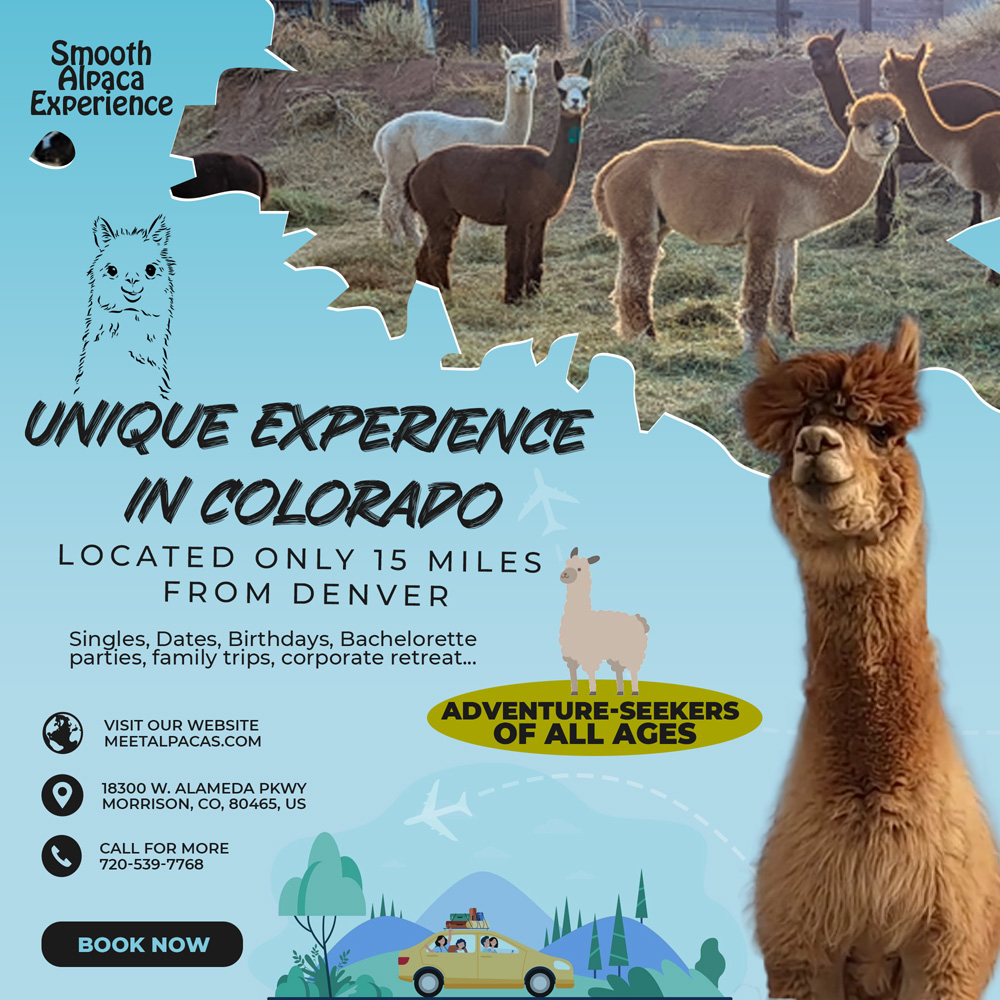Best alpaca experiences and holiday guides in Colorado: Alpacas are low-maintenance animals that require minimal housing needs and lower veterinary bills than many other types of livestock. They graze, not pull, plants down to the roots, so they help maintain pastures and reduce the need for supplemental feeding. Their padded feet cause less wear and tear on the ground than a horse’s hooves, making them an environmentally friendly alternative to traditional livestock. Shearing and processing the fiber is a huge source of income for alpaca ranchers. They sell raw alpaca fiber to groups that turn it into finished goods and participate in local and national alpaca shows. They may also stud their females (female herd sires) with other alpaca owners for a fee. Find extra info on alpaca adventures package in Denver, Colorado.

You can walk with an alpaca on your own or participate in guided tours and vineyard retreats, ranch stays, and farm dinners. The farm walks are often over rocky, sometimes muddy, and wooded terrain, so hiking boots or tennis shoes are recommended. It’s important to spread out as alpacas can kick if they feel threatened or are startled. If you’re a nature lover, there’s plenty of time to explore the scenic property’s rolling hills, forests, vineyards, and ponds. A picnic lunch is available for guests at the onsite restaurant, or you can bring your own to enjoy in a designated area.
Here’s why an alpaca experience is perfect for your upcoming trip to Denver. Alpacas are adorable, fluffy, and friendly animals. People are often surprised by just how sociable they are and how much they enjoy human affection. They are also incredibly calm creatures with steady temperaments. This makes them perfect for the whole family. They don’t display erratic behavior, making them more predictable around children.
As herbivores, alpacas only eat vegetation. They eat mostly grass, but their diets can also include leaves wood, bark or stems. Like other ruminants, alpacas have a three-chambered stomach that digests the roughage efficiently. Unlike other grazers, alpacas don’t eat much. According to the Alpaca Owners Association, a 125-lb. (57 kg) animal only eats around 2 lbs. (907 grams) per day. In general, alpacas eat 1.5 percent of their body weight each day.
It’s a photo-worthy activity: If you’re looking for a fun experience where you can take some Instagram-worthy shots, meeting alpacas is for you. You’ll be able to stand with them, pet them, feed them, and take photos with and of them. Not only are you interacting with an animal you’ve likely never hung out with before, but you’re also doing it in an incredibly scenic state. Capture some photos of you smiling with an alpaca for all your followers and friends to enjoy. When you go behind the scenes on the ranch, you learn about much more than just the animals. You have the opportunity to talk about the economy, trade, production, local handmade goods, and so much more.
What is an alpaca? Alpacas (vicugña pacos) are members of the Camelid Family and are a domesticated species of the South American camelid. Camelids originated in North America over 40 million years ago. Camels migrated east via the Bering Strait and llamas migrated to South America. Today there are five recognized camelids breeds: camels, llamas, guanacos, alpacas, and vicunas. They vary by size and purpose, some being used primarily as pack animals and others valued for their fiber. All are used in a secondary meat market. Camels, llamas, and alpacas have been domesticated for thousands of years, whereas guanacos and vicunas continue to roam freely in herds. Many people are familiar with humped camels: the dromedary of Northern Africa, the Middle East, and Southern Asia, and the Bactrian camel of China and Tibet. Next in size is the llama (domesticated guanaco), followed by the alpaca (domesticated vicuna). Discover even more info on https://meetalpacas.com/.
Are alpacas easy to care for? Alpacas are a small and relatively easy livestock to maintain. They stand about 36′ high at the withers (where the neck and spine come together) and weigh between 120 to 200 pounds. Like other types of livestock, alpacas need basic shelter and protection from heat and foul weather. Good nutrition is essential for healthy animals. Hay, minerals, and fresh clean water should be available at all times. Many alpaca owners also provide a nutritional supplement. Under a veterinarian’s direction, alpacas need vaccinations, preventive medication, and deworming. Alpacas also require yearly shearing to keep them cool in the summer. Alpacas do not have hooves; instead they have two toes, with hard toenails on top and a soft pad on the bottom of their feet. Their padded feet minimize the impact on the pasture. To ensure proper foot alignment and comfort, their toenails must be trimmed as needed.
Alpacas have two sets of teeth for processing food. They have molars in the back of the jaw for chewing cud. In the front, alpacas have teeth on the bottom only and a hard gum (known as a dental pad) on the top for crushing grain, grass, or hay. Unlike goats and sheep that have long tongues which can rip plants out of the ground, alpacas have short tongues and nibble only the tops of grasses and other plants. This results in less disturbance of the vegetation. Alpacas will often eat shrubs or the leaves from trees if given the opportunity. This requires monitoring to ensure they do not consume harmful products.
Alpacas are very social creatures. They are gentle and curious and with training can become great pets, according to Switzer. Herds often include animals of different species or taxonomic families, such as llamas, goats and sheep, according to the FAO. Alpacas spit when they are distressed or feel threatened. They will sometimes spit at each other when they are competing for food or trying to establish dominance, according to Switzer. They won’t spit at people or bite unless they have been abused.